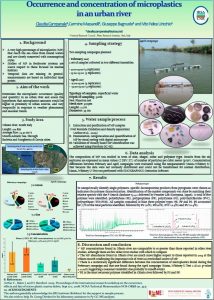Abstract:
Both macroplastic and microplastic contamination levels were assessed for the first time in a tropical river estuary system, i.e. the Saigon River, that traverses a developing South East Asian megacity, i.e. Ho Chi Minh City, Vietnam. The analysis of floating debris collected daily on the Nhieu Loc – Thi Nghe canal by the municipal waste management service shows that the plastic mass percentage represents 11–43%, and the land-based plastic debris entering the river was estimated from 0.96 to 19.91 g inhabitant−1 d−1, namely 350 to 7270 g inhabitant−1 yr−1. Microplastics were assessed in the Saigon River and in four urban canals by sampling bulk water for anthropogenic fiber analysis and 300 μm mesh size plankton net exposition for fragment analysis. Fibers and fragments are highly concentrated in this system, respectively 172,000 to 519,000 items m−3 and 10 to 223 items m−3. They were found in various colors and shapes with smallest size and surface classes being predominant. The macroplastics and fragments were mainly made of polyethylene and polypropylene while the anthropogenic fibers were mainly made of polyester. The relation between macroplastic and microplastic concentrations, waste management, population density and water treatment are further discussed.
Keywords:
Microplastic, Macroplastic, Urban river, Contamination, Anthropogenic fibers
Citation:
Lahens, L., Strady, E., Kieu-Le, T.-C., Dris, R., Boukerma, K., Rinnert, E., Gasperi, J., Tassin, B., 2018. Macroplastic and microplastic contamination assessment of a tropical river (Saigon River, Vietnam) transversed by a developing megacity. Environmental Pollution 236: 661–671.
Link:
https://www.sciencedirect.com/science/article/pii/S0269749117330579


